| Botanical Name |
|
| Family |
Asteraceae - The daisy family. |
| Pronunciation |
|
| Common Name(s) |
English: Osteospermum; African daisy; Cape daisy
|
| Plant Group |
- Ground Cover A plant with a low-growing, spreading habit, grown specifically to cover the ground.
- Perennial A plant whose life cycle lasts for three or more seasons.
|
| Plant Size |
- Medium
| Tree | 10m to 16m |
| Shrub | 1m to 2m |
| Perennial/ground cover | 40cm to 60cm |
| Bulb | 40cm to 60cm |
| Succulent | 40cm to 60cm |
|
| Position |
- Light or Dappled Shade Found below trees with sparse, open foliage. Ideal for the protection of herbaceous plants.
- Partial Shade The area is in shade for part of the day and in full sun for part of the day.
- Sun The area is in full sun for all or most of the day, all year round.
|
| General Information |
- Drought Tolerance: Moderate The plant is moderately adapted to arid conditions and can survive short periods of drought and high temperatures without extra water.
- Evergreen Plants that have leaves all year round.
- Frost: Half-hardy The plant is able to survive low temperatures and some frost but requires protection against severe frost.
- Prune hard after flowering Fast growing shrubs that grow lanky within a season. Cut off branches and stems of these plants to a third of their original length. This will increase the yield of flowers, improve the plants shape and enhance the structural strength of main branches.
- Sand tolerant Plants adapted to survive in nutrient poor, very sandy soils.
- Water Wise Plant species originating from low rainfall regions that require less water to survive and thrive than other plant species.
|
| Specific Information |
Osteospermums are half-hardy sub-shrubs with showy daisy flowers throughout summer and into autumn. They are a perfect indigenous replacement for the traditional Shasta daisy. Osteospermums are described as half hardy perennials meaning that they won't survive cold winters. They can cope with mild frosts, but in areas where the temperatures drop below -2 degrees Celsius they should be treated as annuals. The flowers open fully in direct sun, and close each evening. They bloom best when the nights are cool. During hotter periods of the summer there will be a period of reduced blooms but in cooler periods they will perk back up and put on a fresh show of blooms.
|
| Ad Break |
|
| Flowers |
| Description |
daisy flower up to 8cm in diameter with a blue center on thin stems held above the plant
|
| Season |
- Summer to Autumn Plants will seldom bloom for the entire season as given in the list, but should flower during a period within these parameters.
|
| Colour |
|
| Growth Rate |
- Fast Specifying growth rate can be very misleading as there is considerable variation of growth rate depending on type and species of plant, available water, supplementary feeding, mulching and general care, as well as the plants suitability and adaptability to the garden environment.
|
| Plant Uses |
- Attracts bees, butterflies or other insects This plant attracts insects which can be food for birds or other creatures in your garden.
- Border A strip of ground, at the edge of a driveway or path in which ornamental plants or shrubs are planted.
- Container Trees, shrubs and ornamental species that can adapt to growing in a restricted environment.
- Edging A low growing plant that provides softness or definition to the edges of a bed or walkway.
- Filler Either a fast growing tree or shrub used temporarily to fill in an area while the permanent plants grow to a desired size, or a plant used to fill gaps in borders or beds.
- Ground Cover Low-lying plants that spread fast, require minimal maintenance, and cover large expanses or bare areas between bulbs or shrubs. They provide protection from erosion and drought and improve the visual appearance of the garden.
- Pioneer for new gardens A very fast growing plant, able to withstand hardship, that can be used to populate land that has recently been cleared of natural vegetation. These plants pave the way for slower-growing species by adding nutrients to the soil and creating leaf litter.
- Rock Garden An area constructed of larger rocks, arranged naturally, to emphasise the use of stones as a main element. Generally plants used do not need a lot of care.
- Stabilize Banks Plant is used to prevent soil erosion because their roots will form a mat that stabilizes the soil and keeps it from washing away in heavy rains.
- Suitable for coastal gardens Plants adapted to dry, sandy soil, forceful wind, limited rainfall and intense sunlight.
- Suitable for seaside gardens Plants that will survive the hostile environment of harsh salty winds, dry sandy soil, irregular rainfall and heat found in seaside gardens.
|
| Distribution and Habitat |
|
| Planting Suggestions |
Plants prefer a warm and sunny position and rich, well drained soil, although they tolerate poor soil, salt or drought well. Soggy, poorly drained soil is to be avoided as the roots will rot. Water young plants regularly until they are growing well, then reduce the amount of water. Pinch out the growing tips a couple of times during spring to develop a compact, bushy plant and remove wilted flowers regularly to prolong flowering. I leave a few flowers to seed themselves to provide me with seedling plants for the following season. If not pinched out the stems become lax and lie untidily along the ground. Cut the plants back hard in early spring or in the autumn. In my garden they grow successfully in poor soil and are dependent on rain with a little water only if critically dry. They seed themselves freely so there are always plantlets to spread around the garden. I pull out the bushes after the second year of flowering and allow a couple of seedlings to take their place. I find the white flowered plants particularly useful in the succulent beds where they soften the landscape. Osteospermum hybrids will grow happily in containers. If planted in a container, the soil should not be allowed to dry out completely as the plants will abort their flower buds.
|
| Medicinal Uses |
|
| Ad Break |
|



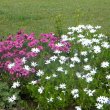
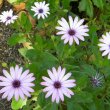
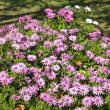
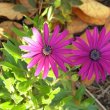
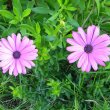
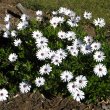
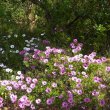


Discuss this plant
Share knowledge, ask a question or give an experience.